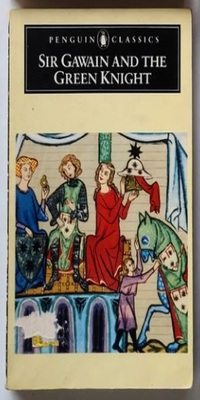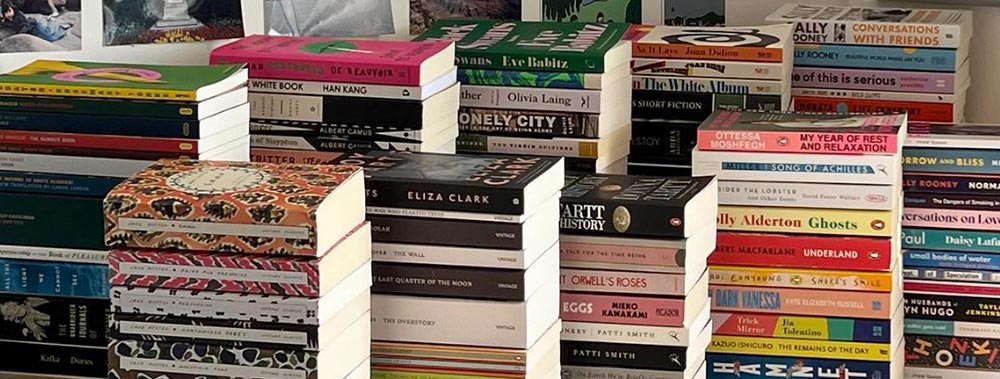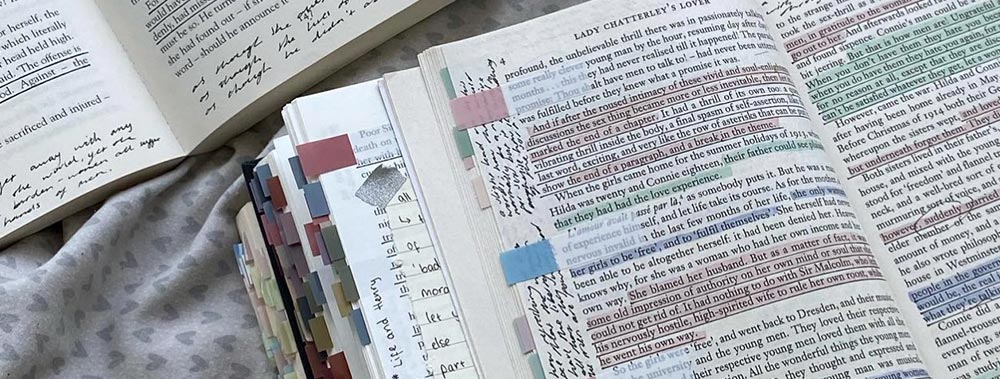Sir Gawain and the Green Knight: Summary, Plot, Characters, Literary Analysis & More
“Sir Gawain and the Green Knight” is a captivating chivalric romance poem believed to have been written by the Gawain Poet in the late 14th century.
This medieval masterpiece weaves together themes of honor, courage, and temptation against the backdrop of King Arthur’s court and the world of knights and chivalry.
First recounted around Christmas Eve in Arthur’s splendid court, the narrative unfolds as a mysterious and imposing Green Knight challenges the valor of Sir Gawain, one of Arthur’s knights.
Gawain accepts the challenge, leading to a series of daring encounters, including the famous scene at the Green Chapel where the Green Knight reveals his true nature.
The exchange of strikes, kisses, and the use of a green girdle are pivotal moments that test Gawain’s loyalty and virtue.
Woven into the fabric of the poem are elements such as the Round Table, Arthur’s court, and the enchanting presence of Morgan le Fay.
As Gawain’s journey unfolds, the poem delves into the complexities of chivalry, trust, and the human struggle against temptation, echoing its enduring relevance to medieval romances and readers alike.

Sir Gawain and the Green Knight is about exploring themes of honor, loyalty, and moral dilemmas through the adventures of Sir Gawain.
Table of Contents
Summary The Plot Characters Key Themes Genres Language used Literary devices Summing upThe Plot
“Sir Gawain and the Green Knight” unfolds in the legendary realm of King Arthur’s court, where festivities are interrupted by the arrival of the enigmatic Green Knight.
This supernatural figure proposes a daring beheading game, offering his own axe to behead anyone who will accept, with the promise of a return blow a year and a day later.
Sir Gawain, Arthur’s valiant nephew, steps forward and beheads the Green Knight, who picks up his severed head and departs, reminding Gawain of their pact.
The plot follows Gawain’s journey as he fulfills his end of the bargain, encountering various challenges and temptations, including the advances of the alluring Lady Bertilak.
Gawain resists her temptations but accepts a green girdle as a keepsake.
On the appointed day, Gawain faces the Green Knight, who swings his axe but only nicks Gawain’s neck, revealing that the initial beheading was a test.
Gawain, wearing the green sash, returns to Arthur’s court, where the Round Table knights don green sashes in solidarity.
The poem explores themes of chivalry, loyalty, and the complexities of human nature, making it a timeless chivalric romance.
Characters
The characters in this medieval romance by the Gawain Poet exemplify chivalry’s complexities.
Sir Gawain’s honor is tested by the enigmatic Green Knight’s challenge, while Lady Bertilak’s temptations probe his integrity.
King Arthur and the Round Table knights add nobility, while Morgan le Fay weaves her magic.
Read on to find a “Sir Gawain and the Green Knight” summary of the characters in greater depth.
Sir Gawain
Sir Gawain is the honorable and courageous nephew of King Arthur, known for his loyalty and chivalry.
He volunteers to play the beheading game with the Green Knight, showcasing his bravery.
Throughout his journey, Gawain faces moral dilemmas and temptations, revealing his complex inner struggle between his code of chivalry and his humanity.
Green Knight
The enigmatic Green Knight appears at Arthur’s court, challenging the knights with a mysterious beheading game.
He embodies both the supernatural and the symbolic, representing nature’s power and the trials that test knights’ honor.
His subsequent interactions with Gawain reveal his role as a tester of character and a mentor, rather than just a fearsome adversary.
Lady Bertilak
Lady Bertilak, also known as the Lady of the Castle, is a captivating and cunning character who tempts Gawain during his stay at her castle.
Her advances challenge Gawain’s resolve and integrity. She presents a complex interplay of seduction and morality, testing Gawain’s commitment to his chivalric principles.
King Arthur
King Arthur, the legendary monarch, presides over a grand and noble court.
He serves as the backdrop for the events of the story and highlights the ideals of chivalry and honor that the knights of the Round Table strive to uphold.
Morgan le Fay
Morgan le Fay, King Arthur’s half-sister and sorceress, is a mysterious figure with a penchant for magic.
She is rumored to have orchestrated the Green Knight’s challenge, adding an element of enchantment and manipulation to the narrative.
Lord Bertilak
Lord Bertilak, Lady Bertilak’s husband and the host of Gawain, presents an intriguing contrast between his seemingly carefree demeanor and the more sinister tests he orchestrates.
His role in the narrative adds complexity to the moral challenges faced by Gawain.
Gawain Poet
The Gawain Poet, the anonymous author of the poem, provides the artistic voice that weaves the intricate tapestry of the story.
Their portrayal of the characters and events reflects a deep understanding of the medieval chivalric romance genre and its themes.
Round Table Knights
The knights of the Round Table, Arthur’s loyal companions, symbolize the ideals of honor and knighthood.
They show solidarity with Gawain by wearing green sashes, emphasizing the importance of unity and shared values in the face of challenges.
Key Themes
“Sir Gawain and the Green Knight” weaves these themes into a rich tapestry, inviting readers to reflect on the moral quandaries faced by its characters and the enduring relevance of chivalric ideals in a complex world.
The Theme of Chivalry and Honor
The theme of chivalry and honor is central to the narrative, as Sir Gawain strives to uphold his knightly virtues despite facing moral dilemmas.
Gawain’s commitment to honor is tested when he accepts the Green Knight’s challenge, and later, when he resists Lady Bertilak’s advances.
His exchange of blows with the Green Knight and his confession of accepting the green girdle showcase his unwavering dedication to chivalry.
The Theme of Temptation and Integrity
Temptation and integrity are intertwined themes as Gawain confronts seduction during his stay at the castle.
Lady Bertilak’s advances challenge his moral compass, highlighting the tension between his loyalty to chivalry and his human desires.
Gawain’s acceptance of the green girdle represents a lapse in his integrity, revealing the internal struggle between upholding his reputation and succumbing to human weakness.
The Theme of Nature and Supernatural
The Green Knight, a supernatural figure, embodies the theme of nature’s power and the uncanny.
His appearance disrupts the festive atmosphere at Arthur’s court, emphasizing the connection between the natural world and the mystical.
The Green Chapel, a remote and natural setting, serves as the stage for Gawain’s final test, blurring the boundaries between the physical and the supernatural.
The Theme of Loyalty and Sacrifice
Loyalty to one’s word and the willingness to sacrifice personal comfort for a higher cause are recurring themes.
Gawain’s acceptance of the beheading challenge exemplifies his loyalty to Arthur’s court and his willingness to uphold its reputation.
His decision to wear the green girdle is both a sign of his survival and a reminder of his momentary lapse in loyalty.
The Theme of the Complexities of Truth
The theme of truth is explored through the intricate web of deception and revelation.
Gawain’s concealment of the green girdle’s origin reflects his internal conflict between honesty and self-preservation.
The Green Knight’s dual identity and the revelation of his testing purpose emphasize the multifaceted nature of truth and challenge notions of appearances versus reality.
Genres in Sir Gawain and the Green Knight
The fusion of these genres enhances “Sir Gawain and the Green Knight,” creating a multi-dimensional narrative that resonates with audiences through its exploration of chivalry, legendary figures, and the mystique of the supernatural.
Chivalric Romance
The poem belongs to the genre of chivalric romance, characterized by tales of knights and chivalry set in a fantastical medieval world.
This genre provides the framework for exploring themes of honor, loyalty, and moral dilemmas through the adventures of Sir Gawain.
The beheading game, Gawain’s encounters, and his internal struggles all align with the conventions of chivalric romance, creating a captivating narrative of knighthood trials.
Arthurian Legend
As a part of the Arthurian legend, the poem is situated within the rich tapestry of King Arthur’s court and the Round Table.
This genre adds layers of familiarity for audiences already acquainted with the legendary characters, while also allowing the author to delve into the complexities of loyalty, kinship, and the pursuit of virtue within this established framework.
Supernatural and Folklore
Incorporating elements of the supernatural, the poem also draws from folklore and medieval beliefs.
The Green Knight’s magical appearance, the enigmatic nature of the beheading game, and the Green Chapel’s remote and mystical setting contribute to an atmosphere of wonder and uncertainty.
These supernatural elements heighten the sense of adventure and provide a backdrop for exploring the boundaries between the natural and the otherworldly.
Language used in Sir Gawain and the Green Knight
The author of “Sir Gawain and the Green Knight” employs a vivid and evocative writing style, skillfully using language to evoke the story’s atmosphere and emotions.
The use of descriptive imagery immerses readers in scenes such as Gawain’s hesitation when he “flinches” at the Green Knight’s axe, highlighting his internal conflict.
The language captures both the grandeur of King Arthur’s court and the eerie ambiance of the Green Chapel.
This creates a sensory experience that amplifies the tension, valor, and moral struggles that define this timeless chivalric romance.
Literary devices in Sir Gawain and the Green Knight
In “Sir Gawain and the Green Knight,” the anonymous Gawain Poet employs a masterful array of literary devices, crafting a rich and multi-layered narrative.
The poem is adorned with vivid imagery that transports readers to the medieval world, capturing the essence of chivalry and honor.
Through the use of symbolism, the Green Knight and the beheading game embody deeper themes of temptation and integrity.
The intricate structure, with its series of tests and exchanges, showcases the poet’s artful manipulation of tension and suspense.
Alliteration and rhythmic patterns add musicality to the verses, enhancing the oral tradition of storytelling.
These literary devices converge to create a timeless work that resonates with readers across generations.
Similes
When the “green knight’s head” is carried into the hall, it’s likened to the “wooing of winter.”
This comparison enhances the reader’s understanding by creating a vivid image of the severed head’s ghastly appearance amidst the wintry setting.
Similarly, as Gawain encounters various challenges, his resilience is compared to “gold refined by fire,” illustrating his enduring strength amid trials.
These similes infuse the text with sensory details and emotions, heightening the reader’s connection to the characters and their experiences.
Metaphors
Metaphors in the poem, like the “lord proposes” and “green knight’s head,” serve as powerful tools for conveying deeper meanings.
The “lord proposes” metaphor echoes not only the lord’s challenge to Gawain but also symbolizes life’s trials that test one’s resolve.
The “green knight’s head” as a “jewel fit for a giant’s ring” offers a metaphorical comparison between the gruesome trophy and preciousness, underscoring the blend of awe and horror.
These metaphors layer the narrative with complex symbolism, inviting readers to explore the intersections of courage, vulnerability, and humanity as seen through the characters’ choices and actions.
Analogies
The “green knight raises” analogy, likening the axe’s rise to a “priest at an altar,” draws a parallel between the ritualistic act and the upcoming confrontation.
The “green knight emerges” analogy, describing his arrival as a “new-hewn knight,” encapsulates his supernatural and imposing presence.
These analogies serve as bridges, enabling readers to comprehend the gravity of events and the characters’ emotions by connecting them to familiar imagery.
Imagery
The green knight mocks with a menacing grin, conjuring a visual representation of his challenge.
The “lady kisses Gawain,” evoking the tactile sensation, exemplifies the poem’s use of imagery to evoke emotions.
The green knight proposes, his words pointed as a spear, harnesses visual and tactile elements, enhancing the intensity of the proposal.
This imagery paints a vivid picture of emotions, actions, and settings, engaging readers in a sensory journey through the medieval world of honor and temptation.
Symbolism
The green knight represents a complex interplay of nature’s power and the trials of virtue.
His mysterious and supernatural presence symbolizes the challenges faced by Gawain and the moral tests inherent in chivalry.
The green knight’s ax acts as a symbol of both danger and judgment, reflecting the dual nature of the challenges Gawain encounters.
The green knight stands as an emblem of the unyielding forces that test Gawain’s character, while the “lord hunts” symbolizes the predator-prey dynamic of Gawain’s situation.
Each symbolic element adds layers of meaning, inviting readers to delve deeper into the narrative’s themes.
Personification
The “green knight laughs” with a “giant’s delight,” infusing his demeanor with human-like emotions.
The “lord hunts,” a humanizing action attributed to a lord, accentuates the tension and challenges Gawain faces.
The “green knight’s ax” is “grim,” personifying the weapon’s intent. These instances add depth to characters and settings, making them relatable and evoking emotional responses from the reader.
By infusing human qualities into the story’s elements, personification enhances the connection between the reader and the medieval world of “Sir Gawain and the Green Knight.”
Hyperbole
When Gawain breaks into heavy breathing before facing the Green Knight’s axe, the hyperbole heightens the tension and underscores his apprehension.
Gawain’s intense emotions are also evident when Gawain refuses to reveal the green girdle’s origin, employing hyperbole to emphasize his internal struggle.
His fervent prayers before the final encounter and his resolute decisions are conveyed through hyperbolic language, showcasing his emotional state.
These exaggerations intensify the psychological depth of Gawain’s character and contribute to the gripping nature of the narrative.
Irony
Situational irony arises as Gawain prays, decides, and sets himself to meet the Green Knight’s blow, anticipating a potentially deadly outcome.
However, the Green Knight’s true intent is to test Gawain’s honesty, leading to a surprising turn of events. This situational irony underscores the unpredictable nature of Gawain’s journey and underscores the complexities of chivalry.
Furthermore, the dramatic irony surfaces when Gawain strikes the Green Knight, unaware of the supernatural resilience he possesses.
This dramatic irony builds suspense and compels readers to contemplate the interplay of knowledge and perception within the narrative.
Juxtaposition
The instances where Gawain “flinches twice” before the Green Knight’s axe highlight his momentary vulnerability juxtaposed against his overall bravery.
The act when Gawain kisses Lady Bertilak serves as a stark contrast to the reminders that “remind Gawain” of his chivalric duty.
This juxtaposition underscores the tension between Gawain’s human desires and his commitment to honor.
These thought-provoking scenarios exemplify the intricate interplay between Gawain’s internal struggles and external challenges, ultimately deepening the reader’s engagement with the complexities of his character.
Paradox
When Gawain happily agrees to play the beheading game, his acceptance of potential danger contrasts with his joyful demeanor, revealing the complex nature of honor and courage.
As Gawain reaches the Green Chapel, a place of foreboding, his anticipation and unease form a paradox that mirrors the intertwining of bravery and trepidation.
Additionally, as Gawain prepares for the Green Knight’s strike, his readiness juxtaposes his uncertainty about the outcome, symbolizing the tension between his commitment to chivalry and his human vulnerability.
These paradoxes accentuate the intricacies of human behavior and the moral dilemmas central to the narrative.
Allusion
The mention of Gawain’s aunt evokes the legacy of Queen Guinevere, symbolizing Gawain’s noble lineage and the ideals he must uphold.
The image of the knight swings recalls the grandeur of chivalric quests and adds a mythical aura to the Green Knight’s challenge. The presence of Queen Guinevere reflects the established Arthurian legend, contributing to the story’s familiarity and depth.
As Gawain finds and returns the kisses, it echoes the complex tale of love, loyalty, and temptation. These allusions anchor the narrative in a rich tapestry of lore, offering readers layers of meaning to explore.
Allegory
When Gawain returns the tokens of Lady Bertilak’s advances to Lord Bertilak, it symbolizes his internal struggle to maintain his honor in the face of temptation.
The episode where Lady Bertilak tells Gawain of her intention to woo him holds allegorical significance, representing the complex interplay of seduction and virtue.
The green horse that Gawain tells of mirrors his journey, serving as an allegory for the challenges he encounters.
The knight picks function as allegorical mirrors, reflecting Gawain’s choices and their impact on his moral journey.
These allegorical elements lend depth to the narrative, inviting readers to uncover layers of meaning beneath the surface.
Ekphrasis
The poem presents instances of ekphrasis, where vivid descriptions of art evoke deeper meanings.
When the lord’s wife wears a fox skin and a wild boar is pursued during the hunt, the imagery reflects not just the hunt’s physicality but also symbolizes the entwined themes of seduction and sacrifice.
The moment when the knight agrees to Lord Bertilak’s proposal involves ekphrasis, as the exchange of winnings becomes a tangible representation of honor.
Even the poem summary, encapsulating the tale’s essence, offers a meta-ekphrasis of the entire narrative. These instances enrich the text, inviting readers to explore the layers of symbolism and narrative complexity within “Sir Gawain and the Green Knight.”
Repetition
Repetition serves as a powerful tool, shaping the poem’s themes and emotional resonance.
The motif of the lord returns is recurrent, emphasizing the cyclical nature of challenges and the interconnectedness of events.
The repeated mention of celebrating Christmas heightens the festive atmosphere, while also symbolizing the renewal of traditions.
The enigmatic old woman, encountered twice, adds a layer of mystique as her role shifts.
Repetition of the phrase Christmas day generates anticipation, culminating in Gawain’s fated encounter.
This strategic use of repetition underscores the themes of continuity, transformation, and the passage of time, further deepening the emotional impact and philosophical exploration of “Sir Gawain and the Green Knight.”
The Use of Dialogue
Dialogue plays a vital role in character development, thematic exploration, and narrative tension within the poem.
Conversations between Sir Gawain and the Green Knight reveal their contrasting values, echoing the tension between chivalry and temptation.
The exchange within the Green Chapel underscores the gravity of Gawain’s moral dilemma.
The Green Knight reveals his true identity through dialogue, unveiling the mystical nature of the narrative. Instances where Gawain flinches emphasize his human vulnerability amidst his knightly courage.
These dialogues not only drive the plot forward but also serve as windows into the characters’ minds, heightening the reader’s engagement with the complex themes of honor and integrity.
Word Play
Wordplay techniques, like puns and double entendre, enrich the narrative’s linguistic landscape.
The Green Girdle, a symbol of Gawain’s inner struggle, carries a double meaning, reflecting both temptation and his dedication to honesty.
The Green Knight’s challenges involve wordplay, as his terms twist the concept of honor. Puns, such as Gawain’s flinches, create humor while illustrating his psychological turmoil.
These linguistic elements add depth and intrigue, inviting readers to navigate the layers of meaning beneath the surface, amplifying the themes of integrity and moral complexities.
Parallelism
Parallelism structures the narrative, fostering connections and reinforcing themes.
The repeated mention of the Green Knight signifies his pivotal role and the central challenge.
The Green Chapel reappears as a symbolic setting, paralleling the beginning and end of Gawain’s journey. The recurring Green Knight summary acts as a refrain, guiding readers through the narrative’s progression.
The parallelism in Sir Gawain and the Green Knight underscores the cyclical nature of human experiences, emphasizing the ever-relevant exploration of honor, temptation, and the complexities of moral choices.
Rhetorical Devices
The poem skillfully employs rhetorical devices to achieve a persuasive impact and amplify its themes. Rhetorical questions, like “Is this Arthur’s hall or another’s?” challenge the perception of King Arthur’s court and evoke introspection.
The use of parallelism, seen in the repetition of “let them” in the Sir Gawain and the Green Knight summary, imparts a persuasive rhythm, underscoring the relevance of honor across time.
These devices guide readers toward self-reflection, inviting them to ponder the implications of Gawain’s choices.
By employing rhetorical tools, the poem encourages critical thinking about chivalry, integrity, and the complexities of human nature, making “Sir Gawain and the Green Knight” a thought-provoking literary masterpiece.
Sir Gawain and the Green Knight: FAQs
This enchanting Arthurian legend, filled with chivalry, mysticism, and moral dilemmas, has captivated readers for centuries.
As we delve into the pages of this epic poem, questions often arise about its symbolism, characters, and the timeless themes it explores.
In this section, we unravel the mysteries and complexities of this enduring tale, shedding light on the queries that enhance our appreciation of its narrative.
What is the main idea of Sir Gawain and the Green Knight?
The main idea of “Sir Gawain and the Green Knight” centers on the chivalrous journey of Sir Gawain as he faces moral trials, symbolized by the enigmatic Green Knight.
What does the Green Knight tell Sir Gawain at the end of the story?
In the end, the Green Knight reveals his true identity as Lord Bertilak, explaining that the challenges were tests of Gawain’s integrity and honor.
What happens when Gawain cuts the head off the Green Knight?
When Gawain cuts off the Green Knight’s head, the knight picks it up and reminds Gawain of their agreement to meet at the Green Chapel, initiating Gawain’s quest to fulfill his promise.
Does Galwin ever find Green Chapel?
Yes, Gawain eventually finds the Green Chapel in the poem “Sir Gawain and the Green Knight.”
After a series of trials and challenges, Gawain reaches the chapel to fulfill his end of the bargain with the Green Knight. This climactic encounter marks a pivotal moment in the narrative’s exploration of honor and integrity.
What happens when the Green Knight reveals his true identity?
The Green Knight reveals his true identity as Lord Bertilak at the end of the story.
He explains that the challenges and tests Gawain faced were orchestrated to assess Gawain’s adherence to chivalry and honesty.
This revelation adds a deeper layer of meaning to Gawain’s journey and the themes of the poem.
Summing up: Sir Gawain and the Green Knight: Summary, Plot & More
In “Sir Gawain and the Green Knight,” the Gawain Poet weaves a tapestry of chivalry, honor, and moral complexities.
Through vivid imagery and allegorical elements, the narrative explores Gawain’s journey of virtue amidst temptation, symbolized by the enigmatic Green Knight.
Literary devices like symbolism, allegory, and wordplay contribute to a multilayered narrative, inviting readers to delve into themes of integrity, vulnerability, and the paradoxes of honor.
The poem’s dialogues reflect the internal struggles of the characters, while rhetorical devices provoke introspection, urging readers to consider the implications of their choices.
The careful use of repetition and parallelism reinforces the cyclical nature of human experiences and the timeless themes addressed. As Gawain faces challenges, flinches prays, and decides, his journey becomes a mirror reflecting the intricacies of the human condition.
“Sir Gawain and the Green Knight” stands as a testament to the complexities of medieval literature, showcasing the delicate balance between nobility and frailty.
The narrative’s impact lies in its ability to resonate across centuries, offering readers a window into a world of chivalry, morality, and the timeless struggle for honor.
Its enduring appeal stems from its ability to provoke thought, evoke emotion, and challenge notions of virtue, making it an essential masterpiece within the canon of literary classics.







